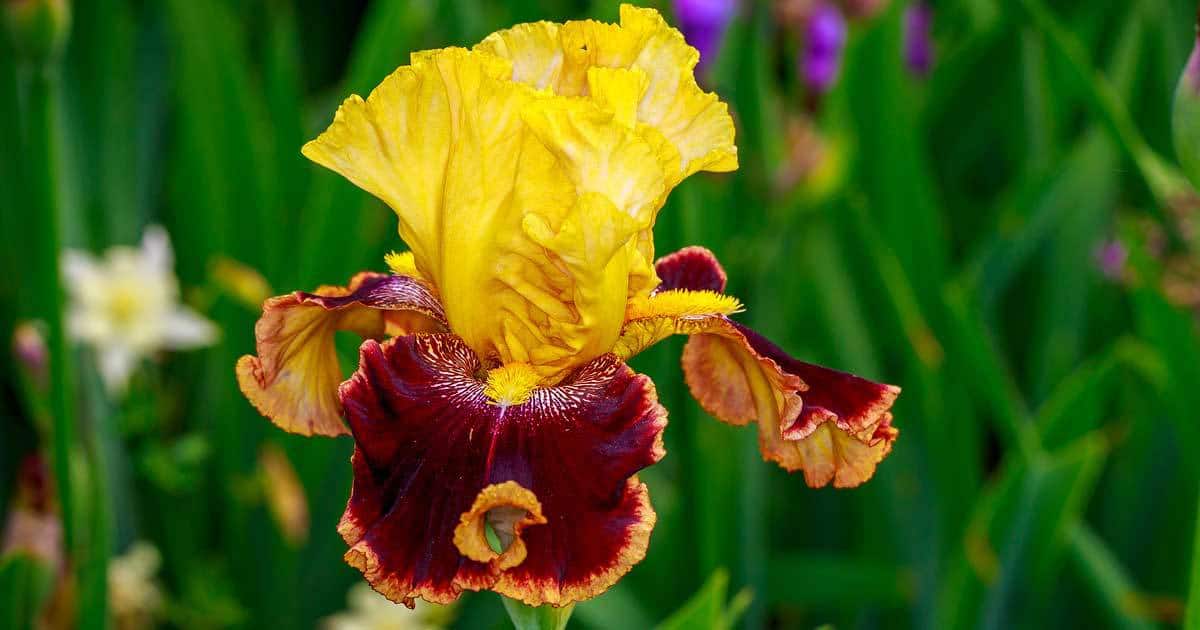If you are asking for tips on how to landscape with Irises and when is the best time of year to plant iris bulbs? Think May! May is when landscape gardeners become conscious that irises are valuable hardy perennials for the garden.
The tall bearded iris has come a long way from the “flags” of grandmother’s day.

Irises, developed over the last 50 years are longstemmed, well-branched, floriferous, and display a glorious array of colors.
They are not to be compared to the dull blues and light yellows that may be found at times in old cemeteries or country churchyards.
Modern iris plants have petals that are not flimsy or droopy. It has heavy substance and fine texture, and the blooms have style and poise. Good branching qualities display each bloom separately.
Iris provides the perennial garden with its most spectacular color of the entire year. Especially here in Mid-America, where the iris seems to enjoy the climate, is this versatile flower appreciated?
Have you ever been asked to view someone’s prize irises only to be led back to see rows and rows of iris flowers in regimental order?
Don’t you wonder why these lovely plants are not arranged to show their total beauty and individual perfection?
Groupings of colors, sizes, and the choice of companion plants all offer challenging possibilities. The iris combines well with other plants. Its leaves and foliage are a garden asset all season long.

Uses When Landscaping With Irises
With all these good attributes, the iris may be used in a multitude of ways. Place a clump of them by a gateway or garden entrance as an accent.
Place them in front of a fence or wall, between climbing roses. Put dwarf varieties at the base of the garden steps. Plant them in clumps in front of evergreens, or in an irregular ribbon along a drive.
Put a handsome variety beside the mailbox (an admirable use for one of the bicolors).
Tall or intermediate varieties do well along the base of drywall—and if the wall has a south exposure, so much the better. Don’t forget the Vesper Iris for blooms in July.
The intermediates may grow from one to two feet high and will adapt well in many rock garden design situations.
For an all-iris planting, edge a path with dwarf irises, back it with intermediates, and then with tall bearded irises.. put yellow roses on a fence or trellis behind it all, for a bank of beautiful color in May.
Learn how to grow reticulated iris in this article.
Mixing A Variety Of Colors
Much could be said about combining iris colors. Yet, these flowers are so generally harmonious that nothing you can do will make them look too bad.
It is a good rule to use complementary colors together… the yellows and bronzes with the blues and purples.
Plant light yellows and browns together… also creams and browns. The experience of a season or two will show which varieties bloom at the same time and look good together.
Part of the fun with irises is the process of moving or planning to move, certain varieties to make the perfect picture.
As for the pinks with tangerine beards, we are now getting so many different shades of pink that we have quite a choice.
Most of these combine beautifully with other colors and produce a startling effect. Delicate pinks go with pale blue or deep purple or maroon; even some of the brown shades go well with the pinks.
White serves as a foil for strong color relief. Use lots of white, cream, and pale blue to subdue vivid colors Be careful to use these in sizeable clumps rather than spottily through the planting.
If you use iris in semi-shaded areas, emphasize the light colors (whites, light yellows, light blues) to show to the best advantage in the shadows.
Put deep colors, maroons, purples, dark blues, and brown blends, where the sun will brighten and show the rich coloring.
Companion Plants of Irises
In the perennial border, there are many excellent companions for the iris. Use lots of columbine for its contrasting foliage. Dames Rocket, Sweetrocket (hesperis), coralbells, blue meadow sage salvia, and pyrethrum are good materials.
In the spaces between iris clumps, use narcissus and lilies, to lead into the iris season and to bloom afterward.
Hybrid hemerocallis, phlox, penstemons, and chrysanthemums are also used with iris to keep the garden in bloom.
And never overlook the peony, traditionally the flowering companion of the iris.
Together with roses for a backdrop, irises and tree peonies will make the garden literally a flower of bloom in May and the first of June.
Besides the tall bearded types, try some of the other irises. Siberian iris thrives in semi-shade or full sun.
When left undisturbed, for several years, iris makes thick and showy clumps ranging from white through the blues to deep purple and wine. It is one of the finest plants for the perennial border and prolongs the iris blooming season.
Japanese iris differs from other irises in that it requires more water, acid soil, and dry feet in winter.
The colors range from pink, red, blue, lavender, purple, to white. This iris is recommended for tall borders. It and the Louisiana iris are ideal for planting around pools, ponds, and in low places.
Dutch iris makes a delightful companion for tulips and is especially good for cutting. Be careful to note where you plant these, as they become dormant and disappear during summer.
If you love irises and enjoy flowers year-round, check out the Algerian Iris.
The dwarf irises are right at home in a rock garden. Early and free flowering, they are true miniatures of their splendid relatives.
Some of these little fellows are so short that the tips of their petals actually touch the ground.
Let them form a colony atop a stone outcropping or drywall, Or use them as edgings in the informal flower beds.